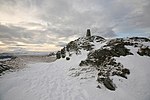Wallowbarrow Crag
Cumbria geography stubsFells of the Lake District

Wallowbarrow Crag is a hill of 292 metres (958 ft) in the Lake District, England. It is on the west of the Duddon Valley, across the valley from the village of Seathwaite. Wallowbarrow Crag is a Fellranger, being included in Mark Richards' The Old Man of Coniston, Swirl How, Wetherlam and the South as one of the 18 (now 21) of his 227 (230 with the extension of the national park) summits which are not in Alfred Wainwright's list of 214. It is also classified as a Tump. It is a recognised site for rock climbing.
Excerpt from the Wikipedia article Wallowbarrow Crag (License: CC BY-SA 3.0, Authors, Images).Wallowbarrow Crag
Park Head Road,
Geographical coordinates (GPS) Address Website Nearby Places Show on map
Geographical coordinates (GPS)
| Latitude | Longitude |
|---|---|
| N 54.360715 ° | E -3.198308 ° |
Address
Wallabarrow Camping Barn
Park Head Road
LA20 6BA , Dunnerdale-with-Seathwaite
England, United Kingdom
Open on Google Maps









